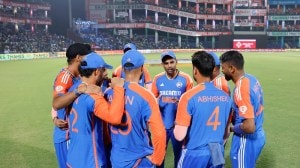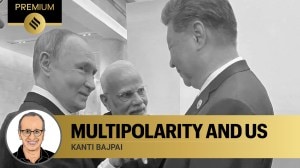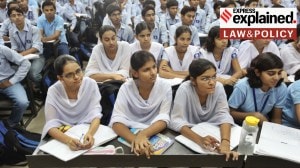Gabbar Singh in Gulmarg
A craving for Bollywood in Kashmir has lead to indigenous remakes,digital recordings of songs and a profusion of indoor studios,which reproduce Bollywood classics with a regional flavour
A craving for Bollywood in Kashmir has lead to indigenous remakes,digital recordings of songs and a profusion of indoor studios,which reproduce Bollywood classics with a regional flavour
Thakur yumi athe di mei (Thakur give me this hand), says Gabbar in chaste Kashmiri. Gabbar and his famous team of Sholay are once again on the screen but this time the movie has been shot not in the wilds of Ramgarh but in the picturesque meadows of Kashmir like Sonamarg,Yusmarg,Budgam and Ganderbal. The actors in this Kashmiri remake of Sholay are not Bollywood superstars,but amateur Kashmiri artists. Gabbar doesnt look like the original Amjad Khan,he has a smaller,thinner frame,but the same flourishing moustache. A local girl plays the role of Basanti,in iconic Hema Malini style,driving her horse Dhanno through the meadows of the countryside. The film Sholay,(2009),made in Kashmir,has already sold thousands of copies across the state.
People in the Valley are crazy about Sholay, says Hamid Khan,director of the films Kashmiri version. In Khans Sholay,the sequences,sets and shots are similar to the original and only the names of some places have been changed to suit the Kashmiri audience. The names of the characters,however,are unchanged. The success of Sholay has encouraged Khan and his team,and producer Mohammad Shafi Akbar is planning more such films. I am now planning to make few more feature films like Ram aur Shyam,Khoon Pasina and Lagaan, he says.
Small-time actors also perform the roles of Dharmendra and Vinod Khanna in the Kashmiri version of Mera Gaon Mera Desh. This film too was shot in the Valley in 2011 with a modest budget of about Rs 4 lakh. Compact discs of the Kashmiri version of Kolaveri di sung by local artists Umar Shah and Muneeb Tibetbakal have turned into a runaway success in the entertainment-starved Kashmir valley. Artists and a few private production houses have also made digital videos of popular Bollywood songs in Kashmiri,which are doing well.
In August 1989,when militancy erupted in Kashmir,a lesser known militant group,Allah Tigers (Tigers of God) imposed a ban on the screening on films in cinemas. Succumbing to militant pressure,all 15 cinemas in the Valley stopped screening films. Soon paramilitary forces occupied the cinemas,turning entertainment halls into dark chambers.
In the late 90s,to revive cinema and as a symbol of peace,the government offered lucrative packages to theatre owners and ordered the security forces to vacate the halls. Three theatres in Srinagar Neelam,Regal and Broadway started screening feature films. But,after a grenade blast,Regal cinema was the first to shut down. Subsequently the owners of Broadway cinema turned it into a hotel. And last year,the last functional cinema hall,Neelam,in the old city,also closed down. Other owners too have converted their cinemas into hospitals or shopping malls.
But the craving for Bollywood was satisfied by the production of digital videos and compact discs of Hindi numbers featuring local artists and filmed on video cameras in the locales of Kashmir or at one of the many indoor studios,which came up in Srinagar over the last year.
Zahoor Shah,who owns the Valleys oldest production house,Music Tape Industries (MTI),says that they have produced 3,000 songs and Kashmiri item numbers in the past decade. Our latest video album is a remake of Kolaveri di. We have already sold hundreds of copies of the Kashmiri version. We have not changed it much; it is just the remake of the original with Kashmiri lyrics.
On the outskirts of the city,in 2010,Shah set up a spacious studio equipped with the latest gadgets and cameras,We record both audio and video albums here. Almost every artist who has a name in the Valley has performed at our studio.
Shah has already produced two Kashmiri feature films,with typical love themes,Habba Khatoun and Mendhi Raat,besides,dozens of telefilms in Kashmiri and Urdu. We are now working on a big budget feature film in Kashmiri,Gulrez,based on a Persian epic. While the movies might be doing well,Shah feels let down by piracy. In the absence of cinema halls,people used to seek entertainment through our audio and video CDs but piracy is a threat to our industry and we lose money through pirated video CDs.
Zafar Salati,who has produced and directed more than a dozen video CDs,says his video albums can be found at different tourist destinations like Gulmarg,Pahalgam and Sonmarg. In 2004,I produced the first video album on a similar pattern as Bollywood. And,within days of its release it was a great success.
Salati,who has a business background,says that digital video discs of remakes of Bollywood songs,by Kashmiri artists,are turning into a great source of entertainment in Kashmir,encouraging young talent and providing good business. We can earn in lakhs after selling these CDs, he says,adding,In rural Kashmir,many people dont have access to cable television and so there is a great market for these CDs. Salati,who has named his production house Z Series,says that around a hundred local artists are on his retainer. I am already working on three new digital video albums.
He says that shooting in Kashmir doesnt always require studios. In Kashmir,every place is scenic. And,we get beautiful frames at every location. One such beautiful locale is Batapora a scenic spot in central Kashmir that replaced Ramgarh from the original Sholay.
It is not only the directors and producers who are enjoying the success,actors who earn Rs 5,000 to 10,000 to perform a role in a film,serial or songs,also see the rise of a new dawn. After acting in these films,we are getting recognition for our talent, says Ashraf Nagoo,who plays the role of Gabbar Singh.
Noted theater personality of Kashmir,Tariq Javid who has produced and co-directed Kashmirs first digital feature film Akh Daleel Louluch,(A Love Story) says that films and video albums despite some professional glitches are selling well.
While there is no official estimate about the quantum of business,it is clear that in the absence of conventional theatre halls,the artists and people of Kashmir have found new ways of entertainment and are indifferent about issues of copyright themselves. No wonder Gabbar Singh can now be found wandering the high valleys of Kashmir.
Photos







- 01
- 02
- 03
- 04
- 05























